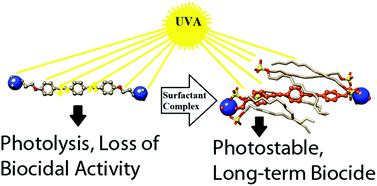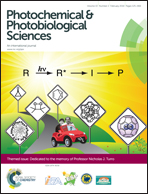Cationic oligo-p-phenylene ethynylenes form complexes with surfactants for long-term light-activated biocidal applications†
Abstract
Cationic oligo-p-phenylene ethynylenes are highly effective light-activated biocides that deal broad-spectrum damage to a variety of pathogens, including bacteria. A potential problem arising in the long-term usage of these compounds is photochemical breakdown, which nullifies their biocidal activity. Recent work has shown that these molecules complex with oppositely-charged surfactants, and that the resulting complexes are protected from photodegradation. In this manuscript, we determine the biocidal activity of an oligomer and a complex formed between it and sodium dodecyl sulfate. The complexes are able to withstand prolonged periods of irradiation, continuing to effectively kill both Gram-negative and Gram-positive bacteria, while the oligomer by itself loses its biocidal effectiveness quickly in the presence of light. In addition, damage and stress responses induced by these biocides in both E. coli and S. aureus are discussed. This work shows that complexation with surfactants is a viable method for long-term light-activated biocidal applications.

- This article is part of the themed collection: Dedicated to the memory of Prof. Nicholas J. Turro

 Please wait while we load your content...
Please wait while we load your content...